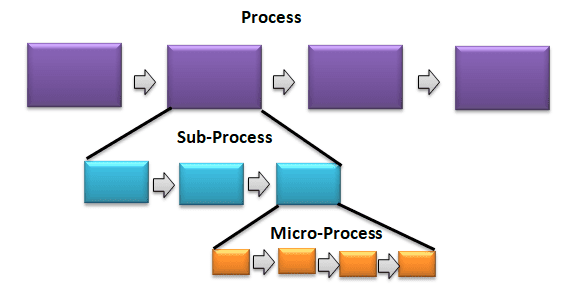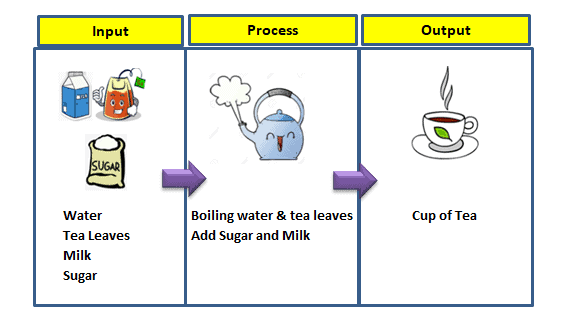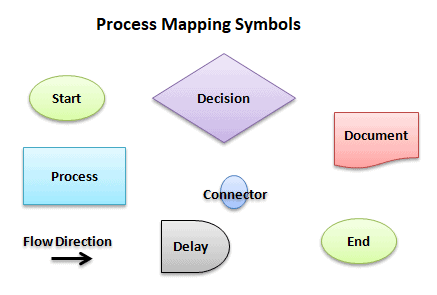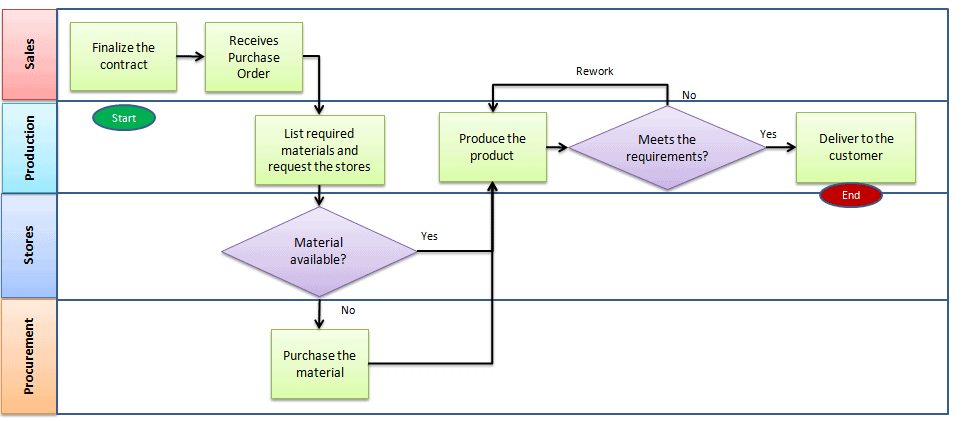In Six Sigma DMAIC, determining how to define a process is one of the critical aspects of the approach, as it is the basis for identifying sub-processes and, eventually, the improvement project or problem-solving projects.
Defining the process assumes that you have already created the project charter, set up the project scope, and now identify some ways to visualize a process.
The level of detail required to define the process depends on both the improvement opportunities and the complexities of the problem. Based on complexity, processes can be viewed as both micro or sub-processes and constituents of more extensive macro processes.

What is a Process
A process is an organized group of related activities that combine to transform one or more kinds of input into outputs that are of value to the customers. In other words, a process is an activity or group of activities that takes the inputs, adds value, and provides outputs to internal or external customers.

The process is a set of activities that interact with one another. Often, the output of one process is the input of another process. The activities which are in relation to a process of importance should be documented and controlled.
Six Sigma can be used to address problems within the manufacturing process or within any business process.
Why define a process
- You have a project started, or you want to start a project
- To understand the project scope clearly
- Finding the pain areas in the process
- You’re handling VOC or Kano addressing some defect or improving a dashboard, KPI, or other measures.
- To understand the process from the perspective of the customer.
How to define a process
- Get the general overall picture of the process and observe the process in action.
- Understand the Voice of the customer and think about y=f(x), where x is the input, f is the function, and y is the output of the process.
- Determine CTQs and list all the steps
- Understand the process interdependencies
- perhaps use the basic root cause analysis with Ishikawa fishbone or a similar analytic tool
- Interview associates and other stakeholders involved in the process
- Start with outcomes like deliverables and trace backward, making a SIPOC
- Be sure to state where you are beginning and ending clearly. It’s easy to have scope creep.
- Use Process definition tools.
- SIPOC, Process map, Value Stream Map
- Review operating procedures or manuals.
- Finally, all the team members must have an overall understanding of the process.
Don’t forget to do a final confidence check that you mapped the right process! It’s easy to go overboard.
Tools for Defining a Process
SIPOC
SIPOC is a high-level process mapping tool to help visualize a process and its influences. In other words, it is a useful tool that depicts how a process serves the customer and summarizes the inputs and outputs of a process in a visual format.
The acronym for SIPOC stands for Supplier, Input, Process, Output, and Customer.
Elements of SIPOC
- Supplier to the process
- Inputs (X’s) for the process
- Process steps
- Process outputs- what the process produces
- Customers- Who receives the product or services

Process Mapping
Process mapping is the graphical representation with illustrative descriptions of how things get done. It helps the participants visualize the process details closely and guides decision-making. One can identify the major areas of strengths and weaknesses in the existing process.
The major components of a process map include the inputs, outputs, and steps in the process. A good process map should illustrate the workflow and the organization’s interaction. It should use a common language (symbols) that everyone easily understands.

An ideal process map should contain proper detail regarding multiple paths, decisions, and rework loops.

Types of process maps
There are two major types of process maps: Process flowcharts and Deployment flowcharts.
Process Flowchart:
A process flowchart is a simple process map that visually represents the sequence of activities along with their points of decision. These flowcharts provide the basic details of the process, which can later be augmented by adding different staff roles.
Deployment Flowchart:
These process maps provide the interactions between different departments and the roles performed by different people in the organization. Also termed ‘swim-lane’ charts, these process maps have vertical lines showing the movement of the process from person to person.
Value Stream Mapping for Defining a Process
Value stream mapping visually represents the flow of materials and information throughout the organization. It visually shows the important parameters like cycle time, lead time, inventory or waiting time, % complete and accuracy, and the number of operators. Three important steps of VSM:
- Create as-is current state process of how an organization delivers products and services to the customers
- Identify wastes in the process and draw the proposed improved state map using lean principles
- Finally, develop and implement action plans to achieve the proposed improved future state

In fact, depending on the business requirement, process mapping or value stream mapping can be used in the organization. Use VSM to determine how much time the product spends on each step and to find the waste in the process. Process mapping is to visualize a series of steps and determine the decision-making within the process.
When to use process definition tools

Benefits
Defining a process provides an ideal opportunity to identify inefficiencies and sources of error.
- It helps identify the duplicate or identical activities performed at different process steps.
- Identify unnecessary tasks such as unnecessary approvals, handoffs, etc.
- It helps identify an inefficient sequence of steps that leads to delays and reworks.
- It helps identify unclear responsibilities, which leads to delays in decision-making.
How to define process video
When you’re ready, there are a few ways I can help:
First, join 30,000+ other Six Sigma professionals by subscribing to my email newsletter. A short read every Monday to start your work week off correctly. Always free.
—
If you’re looking to pass your Six Sigma Green Belt or Black Belt exams, I’d recommend starting with my affordable study guide:
1)→ 🟢Pass Your Six Sigma Green Belt
2)→ ⚫Pass Your Six Sigma Black Belt
You’ve spent so much effort learning Lean Six Sigma. Why leave passing your certification exam up to chance? This comprehensive study guide offers 1,000+ exam-like questions for Green Belts (2,000+ for Black Belts) with full answer walkthroughs, access to instructors, detailed study material, and more.


Comments (2)
hi Ted,
I have a question about the accuracy of the value result, if my customer spec and tolerance is 1.20 to 1.21 ±.01, the test result must be 1.xxx, three place or only two place?.
thank you
Jamie
Hey, Jamie
This depends on how precise your measurement system is and what your customer requires.
But generally:
If your customer specification is given to two decimal places (e.g., 1.20 to 1.21), then:
If your measurement tool gives three decimal places (e.g., 1.204), then:
Some areas of caution:
Best Practices: